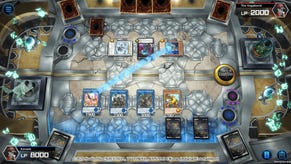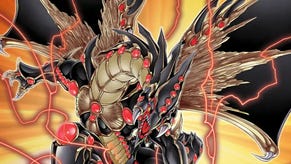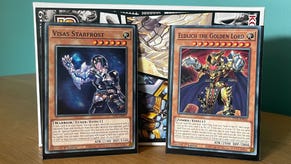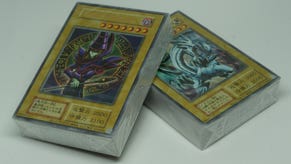Yu-Gi-Oh! European champion Marcus Patel on his unbeaten Rikka deck and the social side of TCG tournaments
Returning to in-person events after COVID.
What is the appeal of competitive Yu-Gi-Oh? It’s a question arguably worth revisiting now more than ever, at a time when the game has inevitably been threatened in recent years by world events. After all, how can a card game reliant on meeting in person succeed in a post-COVID world that, until earlier this year, made doing such a thing with thousands of strangers impossible? Remote events are one thing, with Konami keeping the game active through Remote Duel tournaments, but they’re no replacement for the real thing.
Which made the 2022 competitive scene an exciting event for many. World Championship tournaments may once again have been put on ice as COVID made it too difficult to plan such a major event many months in advance, but beyond this a full regional and international tournament calendar took place for the first time since 2019. Even without a definitive World Champion, we did see the best players from Japan, North America and Europe each individually compete for glory. Returning to in-person events also brought added pressure that made these ultimate tests of player knowledge, where metagame understanding and when to use those all-important side-deck choices are key to victory.
Heading into the European Championships, held in Antwerp between August 19th to 21st 2022, many fans and players expected the tournament to be dominated by one of two decks. One of these was Tearlaments, a Dark Aqua archetype themed around the concept of sending cards from your deck to the graveyard in order to Fusion Summon powerful Extra Deck creatures like Tearlaments Lulucaros.
The other was the Spright archetype, which came out of the recently-released Power of the Elements set to rise to prominence as a speedy and aggressive set of creatures who can quickly special summon themselves to the field before unleashing powerful Rank 2 Xyz monsters and intimidating Link 2 creatures. Both dominated events leading up to the European Championships, and were considered so powerful that many players found it necessary to build a side deck and main deck around countering these opponents.
I wanted a deck that could do well going first and going second.
The winner, in the end, was neither of these. Instead, another overlooked archetype from Secret Slayers that recently received new support in Power of the Elements came out on top, as Marcus Patel of UK pro Yu-Gi-Oh! team The Disciples rose to glory with Rikka.
The expected decks still proved to be stiff competition, with Patel needing to overcome Zio Mundry’s Tearlaments deck in the final to claim victory. Yet it was the element of surprise (and a lot of playtesting) that helped him surprise the competition with a deck others had considered to be a work-in-progress in need of more support by others.
Rikka Sunavalon
Monsters
- 1 Lonefire Blossom
- 2 Mudan the Rikka Fairy
- 1 Primula the Rikka Fairy
- 3 Rikka Petal
- 3 Rikka Princess
- 1 Snowdrop the Rikka Fairy
- 3 Sunseed Genius Loci
- 1 Sunseed Twin
Spells
- 1 Called by the Grave
- 2 Mystic Mine
- 3 Rikka Glamour
- 2 Rikka Konkon
- 2 Sunvine Sowing
- 1 Terraforming
- 3 Triple Tactics Talent
- 3 Unexpected Dai
- 3 Dark Ruler No More
Traps
- 3 Infinite Impermanence
- 1 Rikka Sheet
- 3 Rivalry of Warlords
Extra Deck
- 2 Aromaseraphy Jasmine
- 1 Benghalancer the Resurgent
- 1 Evil Twin’s Trouble Sunny
- 2 Rikka Queen Strenna
- 1 Sacred Tree Beast, Hyperyton
- 3 Sunavalon Dryas
- 1 Sunavalon Melias
- 1 Sunvine Healer
- 1 Sunvine Thrasher
- 1 Sylvan Dancepione
- 1 Teardrop the Rikka Queen
Side Deck
- 3 Appointer of the Red Lotus
- 3 Dimensional Barrier
- 1 Dinowrestler Pankratops
- 3 Evenly Matched
- 1 Evil Twins Ki-sikil & Lil-la
- 1 Harpie’s Feather Duster
- 3 Ultimate Slayer
Prior to the European Championships, Rikka was a Water Plant-based deck beloved for its cute designs and ability to quickly Xyz and Link summon, as well as its tribute-based effects. One of the deck’s most powerful monsters is Rikka Princess, a Level 4 monster that can Special Summon itself from your hand, and has a secondary effect that allows you to shuffle it from your hand or Graveyard into the deck alongside tributing a Plant monster in order to negate an opponent’s monster effect.
Since my opponents didn't have perfect knowledge on what my deck can do, they couldn't make the right decisions all the time.
In combination with spell cards like Rikka Glamour - which can search up to two Rikka monsters that can later also special summon themselves - this is a deck capable of rapid Xyz and Link monsters, spearheaded by its boss monster Teardrop the Rikka Queen and other generic Xyz and Link monsters. Rapid removal, tribute effects and the ability to counter opponent effects and overcome obstacles define the playstyle of this deck, but its ability to synergise with other plant archetypes makes it versatile, tricky opposition for any player to come up against.
Power of the Elements released just a few weeks before the European Championships at the beginning of August, with the deck benefitting most noticeably in this set from the addition of Rikka Konkon to its arsenal, a powerful field spell that could not only search and set Rikka spell and trap cards, but allowed you to tribute your opponent's monster rather than your own plant creatures to activate effects. This not only improved deck consistency by requiring fewer materials, but could be used to overcome pesky monsters your opponent controls.
It boosted the deck’s prospects. Even prior to the European Championships it had begun to make its name with victories at smaller events in the run up to the event, yet it was still not considered a threat players brushed up on or planned methods to counter. Coupled with Rikka’s innate tribute and effect negation capabilities, the deck stood as an effective anti-meta choice to the expected domination of Tearlaments and Sprights, and was a choice that left many opponents blindsided.
“Going into the event, I wanted a deck that could do well going first and going second,” Patel tells me following his undefeated European Championships victory. “The Rikka strategy when going first meant it could set up interruptions that were monster negates, which I thought were very good against Tearlaments, or it could set up cards that remove my opponent's monsters from the board, which is really good in against Sprights because the deck needs Level 2 monsters for the engine to go off.”
With main deck implementation of common side-deck cards like Mystic Mine and Rivalry of Warlords to counter their strength against hand traps with even more options in the side deck for later games, the deck is an oppressive beast going first or second. Much of the deck’s success can be put down to not just playing the archetype but playing the meta. The new cards, the counter and the obscurity of the archetype allowed it to take advantage of the misplays of those unfamiliar with the intricacies of Rikka.
“[Players being less familiar with the archetype] made games a lot easier to win,” admits Patel. “When playing against the deck players tended to waste their resources on what was maybe not the strongest points of interaction, which did help, especially when I was going second and breaking their boards. Since they didn't have perfect knowledge on what my deck can do, they couldn't make the right decisions all the time.”
Travelling, meeting new people, making friends playing a game, for me, is the biggest reason why I wanted to play.
Although Patel was the player to ultimately come out victorious, the deck was very much a team effort from all the members of team Disciples. Alex Robertson, another player on the team, did a lot of the initial planning for the list, and three of the four players to top the tournament using Rikka were from Disciples running the same list they collaboratively strategised over multiple weeks. While the team are skilled players who regularly top at major events (another member, Gabriel Netz, recently topped at YCS Rio de Janeiro), for them, competitive Yu-Gi-Oh! is ultimately an excuse to hang out as friends playing a game they love.
“When I met my friends before we made the team […] I wasn’t on the verge of quitting, but I kind of lost interest in playing the game,” Patel says of Disciples’ origins. “This was around 2017, and I was losing a lot of interest because it just wasn't as fun anymore to go to events and think about and play Yu-Gi-Oh! But since I liked these people I just wanted to travel and hang around with them so it was like, ‘Okay, let's go to an event.’ Since I'm hanging around my friends playing Yu-Gi-Oh!, it was just like 'Why not, I'm going to spend more time with it.' Then, when you're around each other and talking, the subject tends to be about Yu-Gi-Oh!, deck choices, so you’re naturally educating one another on the game. All these small things over a long period of time grow you as a player.
"Now we've gotten to the point where all of us are very good. We do really well at events, because we were able to give each other the best information in the room.”
It’s ultimately this community aspect that the game has missed in its online retreat due to COVID. Even without a World Championships to bring the European Championships and other events to a conclusive end, the journey from regional qualifiers to international championships is a celebration of a game finally returning to the community locked behind a screen for two years.
“I didn’t actually play much during COVID and remote duels because the appeal just wasn’t there,” says Patel. “Travelling, meeting new people, making friends playing a game, for me, is the biggest reason why I wanted to play - even through small things like shuffling each other’s cards in your hands. The reason why the game is growing and why people don’t want to quit is the social aspect.”
So what does this all mean for Yu-Gi-Oh! going forwards? Rikka is already seeing more competitive play since the event, and its place in the meta as a counter-choice has been established. Beyond this, these Championships have signalled the return of in-person competitive Yu-Gi-Oh!, and the fun that comes from playing with friends in a local store or a multi-national event.
A more exciting competitive format, and the return of a more exciting and vibrant local scene: both are equal cause for celebration.










